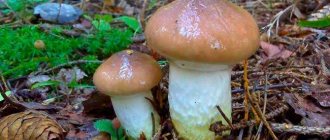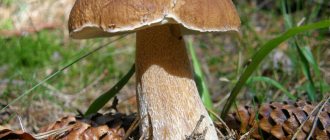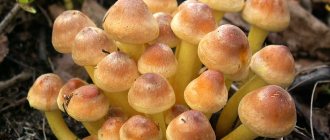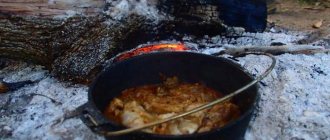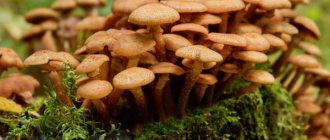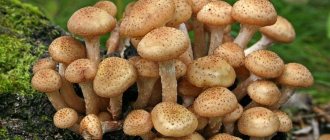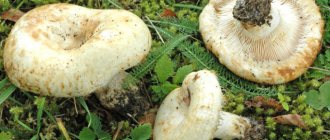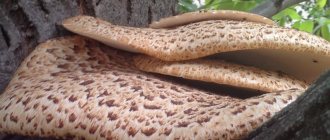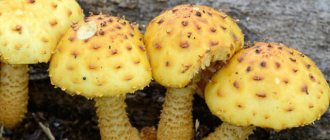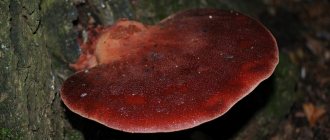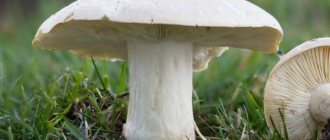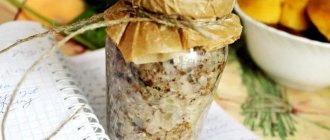Rizhik is a first-class, highest category mushroom with which numerous different legends are associated. Not many mushrooms are pickled using such interesting methods as saffron milk caps.
The name of the camelina mushroom is quite accurate, because it has a red tint. It is noteworthy that this mushroom has practically no synonyms, due to the colorfulness of the name.
The cap of a young mushroom is flat. Over time, it becomes arched. The flesh of the cap is orange in color. The cap has a resinous aroma.
The juice is not pungent, but rather has a bittersweet aftertaste. As for the leg, its shade matches the tone of the cap. Often the leg is equipped with darker colored indentations.
There are several types of camelina: pine and spruce. Let's talk about each of them.
Pine
It is an elegant-looking mushroom, the color of which is mainly dominated by copper and orange shades. It has a stocky, powerful leg.
Sulfur-yellow polypore growing on a tree
This variety causes a lot of controversy even among experienced mushroom pickers, being considered edible by some and completely inedible by others. Only its young caps are used in cooking, since the stem with which the tinder fungus is attached to the wood is too tough and completely tasteless.
If we talk about the structure and development of the tinder fungus, then at the initial stage it looks like dough leaking from a cracked tub, which begins to gradually swell, forming massive lumpy pseudocaps of light yellow, and over time a rich ocher or bright orange color, capable of reaching a diameter of 30 cm.
The pulp of this mushroom has a rather elastic consistency, secreting a large amount of milky juice. But over time, it begins to become woody, losing its original qualities. That is why tinder fungus can only be eaten when it is young, using ripe fruits to prepare various potions and decoctions according to folk recipes.
Spruce
This form is slightly smaller than the previous type and has a less striking color. Spruce saffron milkweed can be recognized by its shade, which contains a maximum of blue and also green shades.
Sometimes the color of the cap can be compared to patina-coated copper. A section of such a mushroom is red in color.
Harvest time
Bear ear.
Camelina is harvested from July to October. The formation of the fruiting body occurs in the warm summer months. At this time, mushrooms are less common and most of them are affected by insect larvae.
Real saffron milk cap is considered one of the latest mushrooms, and it is collected until it is frozen. The most productive harvest month is September, when the camelina growth groups are most numerous.
Inedible camelina
The edible camelina has an inedible counterpart - the amber milkweed.
To see the similarity, look at the photo of the saffron milk cap below. The mushroom has a velvety reddish or reddish-tinged cap. The milk of the inedible mushroom is watery and dries quickly in the air. The taste is bittersweet.
Thanks to the brothy smell, dry milkweed can be used as a seasoning. However, eating fresh mushrooms is prohibited!
Preparing the mushrooms
The saffron milk caps should be prepared by thoroughly clearing the soil. They are a favorite delicacy of mushroom worms, snails and other midges and insects. Processing of mushrooms includes the following steps:
- Sort through the mushrooms, getting rid of wormy specimens.
- Rinse under running water and leave in a bowl of water for one hour.
- Drain the water and place the mushrooms on a paper towel, turning the caps down.
- Young small mushrooms can be selected by immediately sprinkling them with salt. After an hour and a half you can serve fresh. This is an easy to prepare and unusual snack.
- More mature mushrooms for further use in cooking can be pre-cooked for 15-20 minutes.
Where and at what time does it grow?
Mostly mushrooms grow in small forests, sometimes in deciduous forests if fir trees and pine trees grow in them. The mushroom can be found in groups.
Many people look for mushrooms near trees, focusing on their northern side, because they are sure that it is in these places that real delicious edible saffron milk caps grow.
Saffron milk caps appear from the end of June. Rich harvests can be harvested closer to the beginning of autumn. Mushrooms are not afraid of the first frost.
At the same time, summer harvests are watery in comparison with autumn ones, since it is in autumn that mushrooms are stronger and very tasty.
Characteristics of the mushroom
Despite the fact that the description of saffron mushrooms differs slightly depending on the variety, all edible representatives have common features by which they can be distinguished from russula or other lamellar species:
- The cap of young mushrooms is shaped like a cap, and with age it becomes convex and outstretched.
- The color of the skin depends on the variety and the light level of the growth site. In illuminated areas it is almost white, but in dense grass under spruce trees it turns bright red.
- The leg is hollow and brittle. Usually colored the same as the cap, but may be lighter. In some species, the leg is often covered with pits or dark spots.
- The pulp is dense, in most cases white with a contrasting bright color closer to the skin. It produces a milky juice that is removed by soaking before further processing.
Benefits of saffron milk caps
It is impossible to underestimate the properties of camelina, because they contain substances belonging to the azulene series.
Thus, mushrooms are considered an excellent way to obtain a special antibiotic, lactarioviolin, which prevents the development of many harmful organisms, including tuberculosis bacilli. In addition, camelina is enriched with carotene.
Pickles in bottles
Here is a good recipe for saffron mushrooms, photos of which can be viewed on the resource: the point of pickling is that only small mushrooms that can fit into a small neck get there.
Their salting is carried out without the use of spices, that is, without the use of horseradish, garlic, and dill.
Exclusively saffron milk caps with salt. Must be kept in a cool place. You may initially not like the taste of saffron milk caps prepared in this way. However, after a couple of months, the original tart autumn smell will appear.
Marinated mushrooms also taste great. They do not need to add a large amount of vinegar, but it is necessary to add as much spices and granulated sugar as possible. Mushrooms should be cooked for no more than ten minutes.
Preparation
There are many recipes for preparing mushroom dishes from saffron milk caps, but in most cases they prefer to be salted or pickled. Pay attention to several good options for how to cook saffron milk caps at home so that they retain useful substances and microelements.
Pickling
If a large harvest of saffron milk caps has been harvested, they can be cold-salted. This preparation does not involve the use of vinegar, so the appetizer is not only royally tasty, but also healthy.
Ingredients:
- 1 kg of fresh saffron milk caps;
- 40 g salt;
- currant and laurel leaves;
- allspice and black peppercorns to taste.
Preparation:
- Place the peeled mushrooms on a sieve and pour boiling water over them twice. Then rinse with cold water and allow to dry.
- Salt mixed with spices is placed at the bottom of a wooden barrel or enamel container.
- Next, lay out the saffron milk caps, placing them with their caps facing up. The thickness of each row is no more than 7 cm. The layers are sprinkled with salt and pepper.
- The remaining spices are placed on top.
- Cover the workpiece with a clean towel, place a wooden circle on top and apply pressure.
- The container is taken to a cool place.
- In a few days the brine will appear. It must be drained periodically.
The mushrooms will be ready to eat in one to two months. In the future, they can be transferred to jars and stored under an airtight lid in the refrigerator.
Fried saffron milk caps
Ryzhiki can not only be salted, but also fried. A simple recipe loved by many - with onions and sour cream. Chanterelles are prepared in a similar way.
Products:
- 0.5 kg of mushrooms;
- 2 medium onions;
- 200 g sour cream;
- vegetable oil for frying;
- salt and pepper to taste.
Preparation step by step:
- Cut the onion into small cubes and fry until golden
- Peeled and washed mushrooms are cut into arbitrary pieces, lightly rolled in flour and fried separately.
- Onions are mixed with saffron milk caps, sour cream is added, salt and pepper are added.
It is better to serve the dish hot, garnished with fresh herbs.
Photos of saffron milk caps
Shiitake - appearance, composition, benefits and harm, mushroom cultivation + 72 photos- Talker - description of the species, distribution of the species, benefits and harm + 79 photos
- Gall mushroom - description of appearance, seasonality, taste + 69 photos
